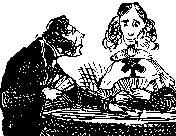The bitter end, part 2
![]()
 |
|
Capablanca, the great chess champion, said
that you shouldn't fear defeat since you learn a lot more from losing than
you do from winning. This is true for cribbage too, and considering that the
best of us lose about 40% of the time, it's good to be philosophical about
failure. Next time you lose a game that you think you should have won, think
of it as an opportunity for self-improvement. Analyze the suspect play, and
find out whether you did something wrong or were just unlucky. Even better,
analyze my suspect plays, and learn from them at no cost to your own
ego. In that spirit, here's another entry from my screw-up file, taken from an Internet game I played in 1999. I was first pone and had been fighting all game against my opponent's superior cards. I'd kept myself in it with defensive play — things like playing 6 on her 10 lead with 5-6-Q-K — hoping for the big break that would turn the tide. That break came on Fourth Street when her cards faltered and I got an 8 cut to my 7-7-9-10, moving me into a tie at 117. Unfortunately my crib was bust, so I needed to win as pone by holding her pegging to three points or less. I was dealt A-4-5-6-7-J. At least that was one J I wouldn't have to worry about cutting. Clearly it was imperative to keep at least four points in hand. Retaining A-4-7-J (the best defensive pegging hand) gave me too many losing cuts (2, 3, 6 and 9). I thought about holding A-4-5-J, which would space out the cards, but I kept 4-5-6-7, figuring that if my 4 lead was paired, I could at least retaliate with the 7, and possibly win the game like this:
The cut was a 10, and I led my 4. My opponent thought a long time, and played a 2:
I ruled out playing my 5 next since it would let her win immediately with a 3. If I played the 6, she could score a 15-2 with a 3 (four losers) or a pair with a 6 (three losers), for seven losers total. If I played the 7, she could score a 15-2 with a 2 (three losers, since she'd already played one) or a pair with a 7 (three losers), for six losers total. So I played the 7, and managed to lose the game against her 2-2-9-Q.
Was I unlucky here? No, I was absentminded. I'd rejected the 6 for giving up a 15-2 to four 3s. What I'd missed is this:
In fact dealer's 3 reply is not a loser for me at all, since it would let me win immediately with the 5. The 6 really has only three losers, making it the better play by a significant margin. When chess players learn how to visualize possible lines of play, they are taught to follow each variation one more play after its apparent resolution to make sure that neither side has an unexpected move that could undo a material gain or other advantage. If I'd looked one more play here, I'd have seen that my 6 wins on a 3 reply. In the event, the pegging would probably have gone:
And the game would have made my highlight reel instead of my lowlight reel. - November 2002 |
|||||||||||||||||||||||||||||||||||||||||||||||||||||||||||||||||||||
![]()
![]() prior
article | Cribbage Forum home |
next article
prior
article | Cribbage Forum home |
next article![]()
Schellsburg home
![]()
Cribbage Forum features articles on cribbage strategy and tactics
by Michael Schell.
Original Material and HTML Coding Copyright © 2002 by Michael Schell. All Rights
Reserved.